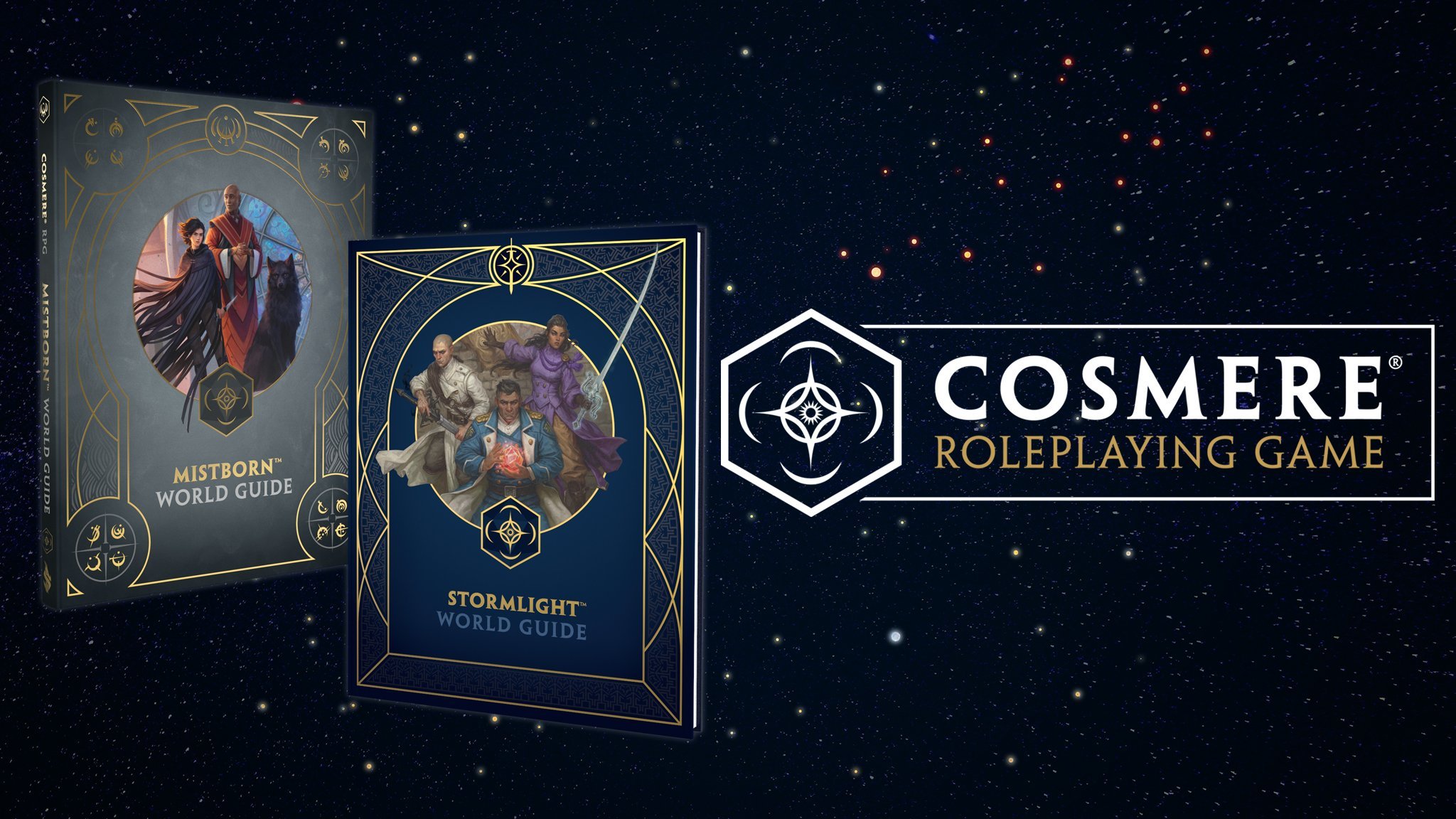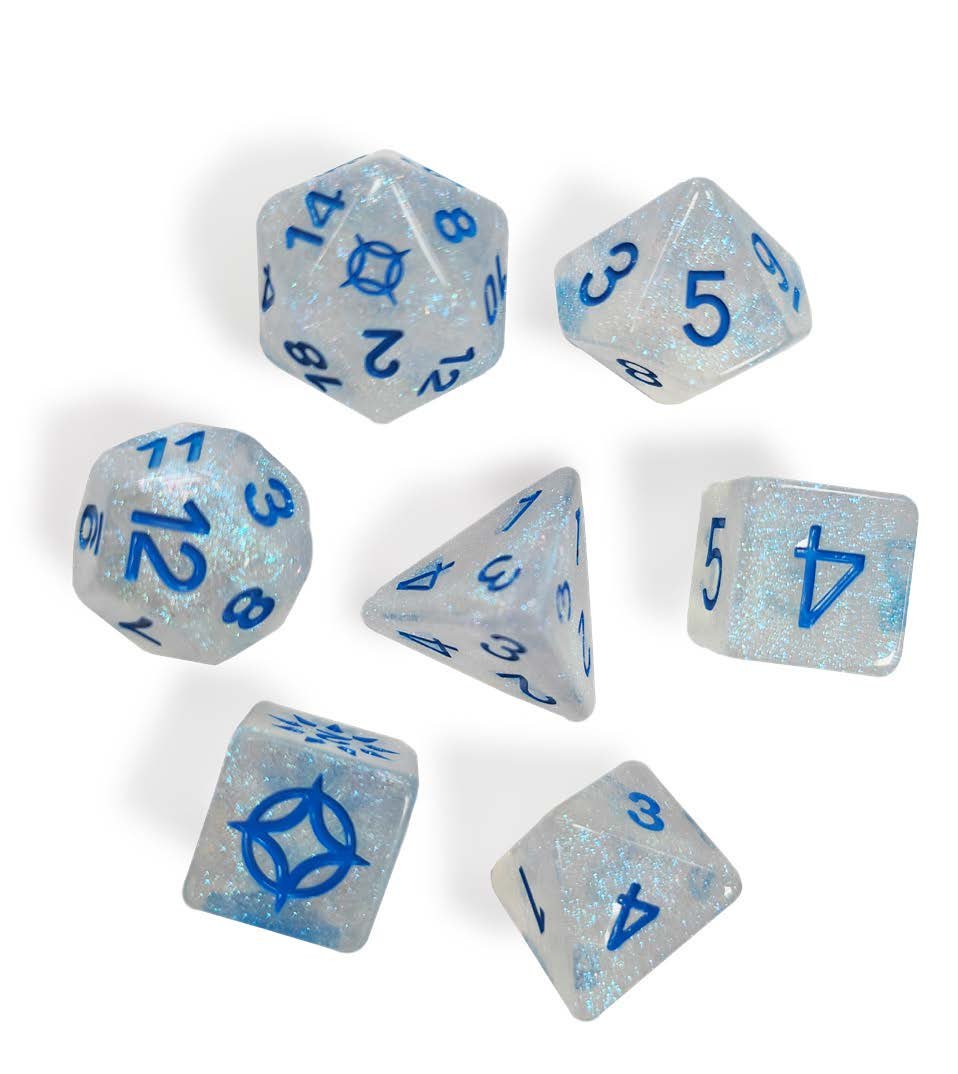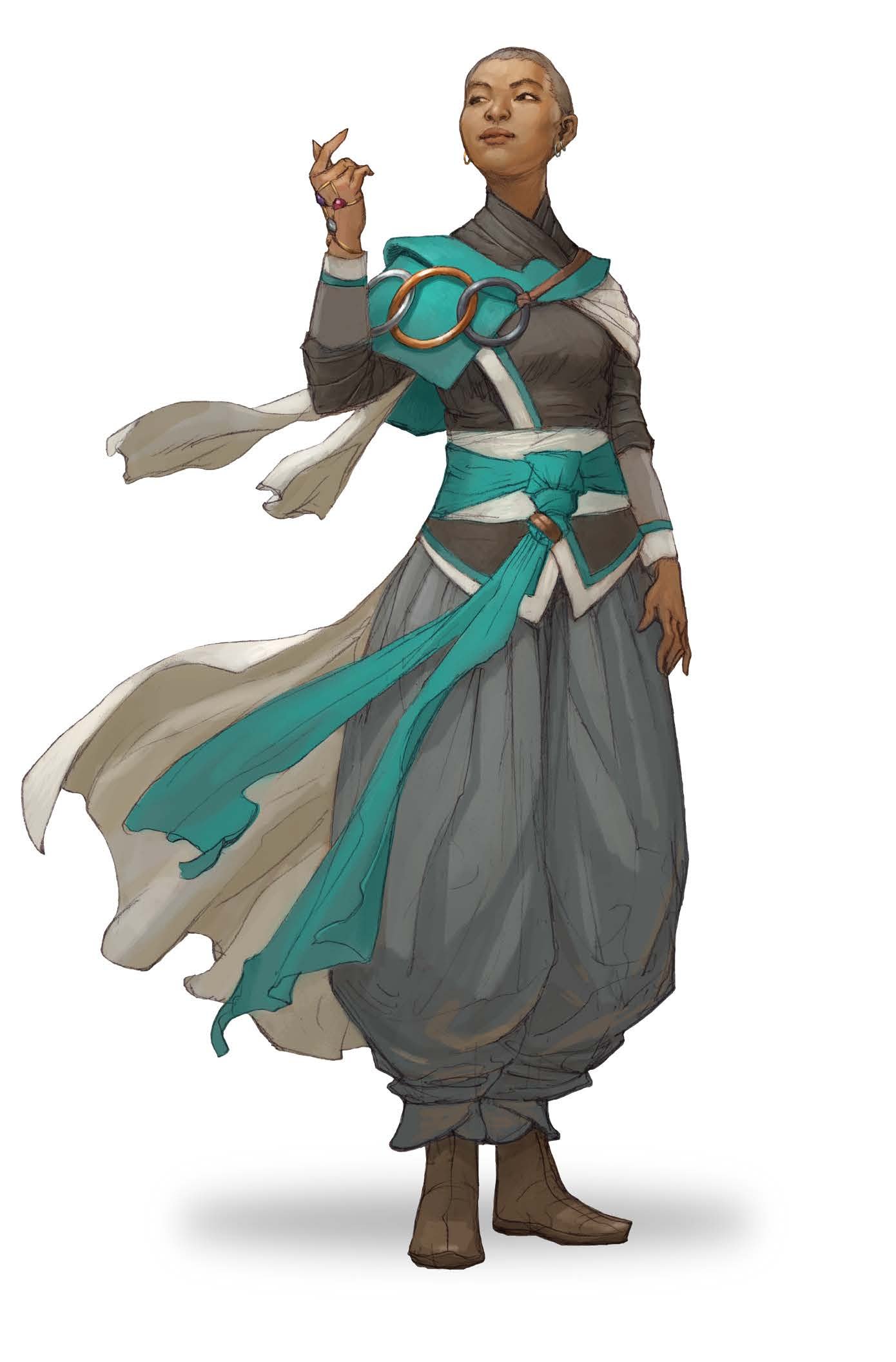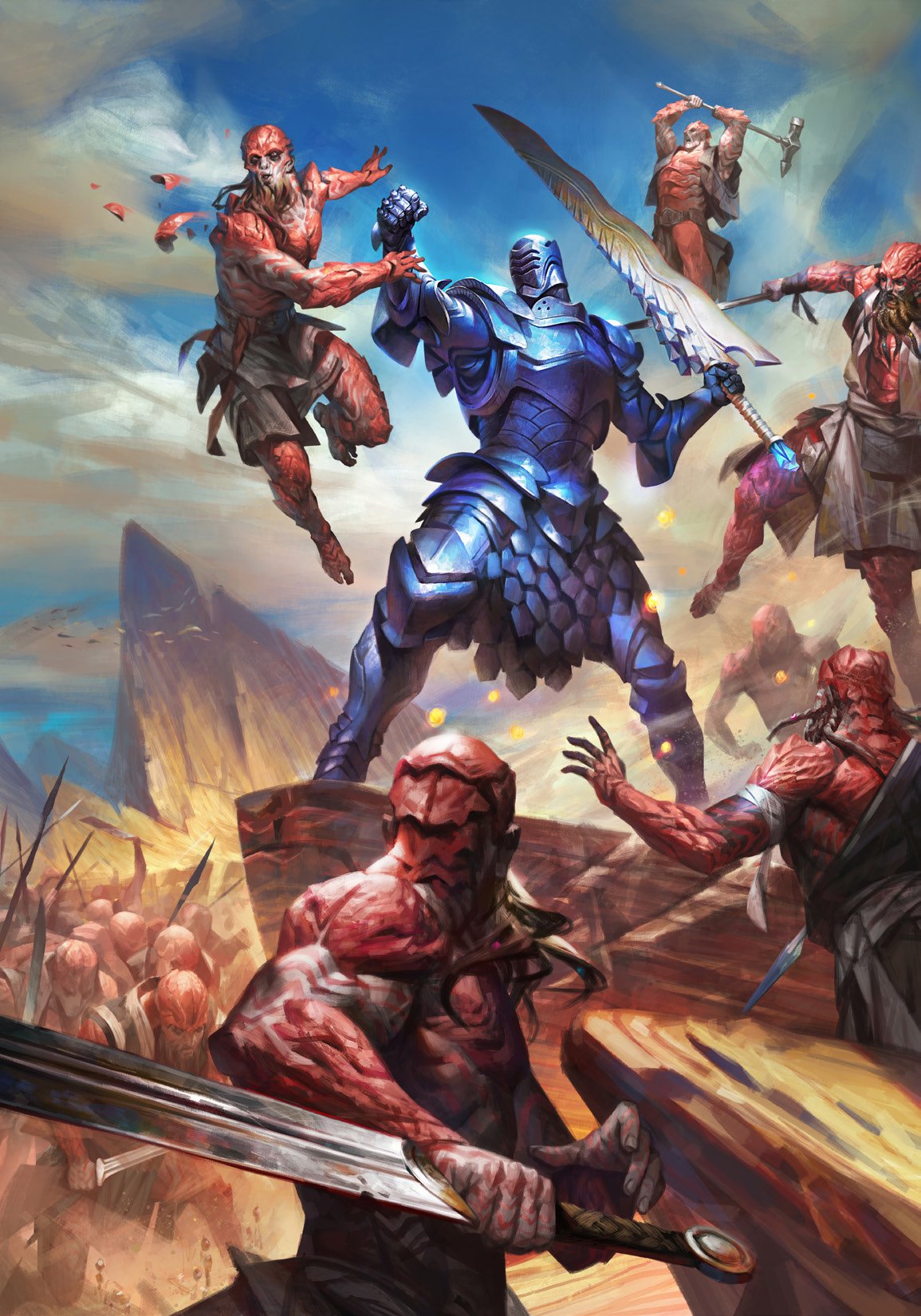Designing the Cosmere RPG
This article originally appeared in Chasmfiend Magazine, a magazine released at GenCon 2024 to share interviews, exclusive content, and behind the scenes looks at the Cosmere RPG.
Shortly after we had started our initial work on the Cosmere RPG, we sat down with Brandon in his epic “secret lair” to talk with him about his vision for the game and how it fit into his books. Sitting at the massive wooden table, surrounded by curios, tropical fish, and beautiful stained-glass windows, I could imagine myself as some explorer of the Cosmere. As part of a wide-ranging discussion about RPGs, Brandon told us stories of the characters he would create when he used to roleplay with his friends. He said that he would look for ways to bend or break the rules, not to simply power-game, but to push the system to its limits and create memorable, impactful characters.
In many ways, the characters in Brandon’s novels carry on this tradition. Most of them live within structured systems, but find ways to bend and push the rules to their own ends. Whether this is Shallan finding new and creative uses for Lightweaving, or Bridge Four testing every corner-case of Kaladin’s powers, Brandon’s characters are constantly carrying on that creative, questioning spirit of his early roleplaying characters. After hearing his stories, we knew that this was a dynamic that we wanted our RPG system to not just capture, but encourage.
This is a tricky dichotomy. To push and pull against a strict rules system, you need a strict rules system in place. But to have the freedom to live the fantasy of a clever rule-bender, you need to have the freedom and leeway to push beyond the rules and use them in creative ways. In many ways, Brandon’s RPG characters were breaking the game system that they were playing in. We wanted to capture that experience, but in a way that our system embraced.
The more we worked on the game, the more we found that dichotomies like this one really defined the core of our system: crunchy rules versus narrative freedom, familiar roleplaying mechanics versus unique elements that evoke Roshar, and powerful Invested characters versus “mundane” character who are just as important to the narrative. Designing the system wasn’t just about balancing these elements, but also about realizing how the two sides of each dichotomy complemented each other. Like the example of Brandon’s characters above, the strictures of the rules form the boundaries that players can have fun trying to exceed. So, to discuss Cosmere RPG design in this article, I want to focus on how we tackled a few of these dichotomies.
BALANCING UNIQUENESS AND FAMILIARITY
While we were out in Utah for the early meetings with Brandon, the core design team was also holding a “creative summit” where we had a lot of in-depth discussions about the vision for the RPG and engage in rapid iteration and testing on some ideas for the core mechanic. This was a time of concentrated teamwork and creative energy, bouncing between testing, brainstorming, and working with Brandon and the team from Dragonsteel. It was some of the most fun I had on the project, and really helped us solidify the vision for the game. Trying to find the right core system had us exploring our first big dichotomy: balancing mechanics that would be familiar and comfortable with those that would feel unique and appropriate to Roshar.
The popularity of TTRPG actual plays and the massive success of Dungeons & Dragons 5th Edition have brought more people than ever before into the hobby. With so many passionate players out there, TTRPGs have never been bigger, and we knew that a ton of Cosmere readers were into roleplaying. We wanted to make sure that our new game would feel familiar and comfortable to them and allow them to dive right in. For that reason, we initially explored using the Open Gaming License (OGL) to make the Cosmere RPG. It certainly felt familiar to players, but there was something missing. There were places that the underlying system just wasn’t able to capture some of the uniqueness of Roshar and the Cosmere. Additionally, there were elements of narrative control and agency that we wanted to give to players that we weren’t quite getting out of the OGL.
So, with those insights, we set out to design and test a bunch of new core mechanics. One feature of many contemporary RPG systems (many of which members of our team had worked on) that we wanted to capture was spectrums of success and failure. We didn’t just want a system that determined a binary success or failure, but one that could sometimes have side effects that complicate the story: a success isn’t just “you succeed,” but can also be “you succeed, but…” or “you succeed, and…” In pursuit of this, we messed around with quite a few different task resolution systems. A couple of them got really close to the mark, but would lose that sense of familiarity that we knew would be important for people to just drop right into the game and start playing.
As you might guess from my theme of “balance” in the intro to this article, our final answer lay in finding a balance between the two approaches we had previously taken. We used a d20 for our main task resolution, but built out the other systems around the d20 to bring in the unique elements we were looking for. GMs can “raise the stakes” at important or climactic moments of the game and bring in a unique “plot die” that gives players and the GM unique ways to affect the story. This system allowed players to drop right in and feel at home, but also start engaging with their story in a way that added a new layer to their roleplaying.
BALANCING NARRATIVE AND CRUNCH
Once the core mechanic was in place, we started working to build out the player abilities (including the reality-warping Surges that Radiant characters would be wielding). As discussed with Brandon in those early brainstorming meetings, it was important that these player abilities be robust and crunchy enough to capture the detail and power of the Surges we see in the books, but open enough to allow for players to experiment and for characters to experience the big narrative swings we see in the Stormlight novels. More specific “crunchier” rules and broader, more “narrative” rules and openings for experimentation can often be difficult to use together, and posed one of the bigger challenges during development.
Luckily, our design team has broad experience with RPG systems in a wide range of complexities and styles. From crunchy systems like Pathfinder 2nd edition and Dark Heresy, to light, fully narrative systems like End of the World, to experimental blends like FFG’s Star Wars system and Modiphius’ 2d20, to the juggernaut of 5e D&D, we brought together a varied set of perspectives.
To leverage these perspectives as we worked on talents (our name for the key abilities and technique that player characters can unlock), we had several different designers take on different talents, and then bring them back together to compare and contrast the different approaches.
This led to some great insights on how to blend the two approaches. I unfortunately don’t have room in this article to dive into a ton of specifics (you’ll just have to check out the game itself), but one example comes in the implementation of the Surges. Instead of treating them like spells in other RPGs (as fixed abilities with specific costs) we made them entire skills in their own right. That way they can be used as flexibly and creatively as Persuasion or Stealth, but can also have talents that build specific, powerful abilities off of them. So the GM has the tools to adjudicate and call for tests when someone wants to use Gravitation in a new unique way, but the PC also has a specific talent telling them exactly how to resolve damage when flinging an object with Gravitation as an attack.
BALANCING RADIANT AND “MUNDANE” CHARACTERS
Having talked a bit about how we made our talents, I’d like to end this article talking about another dichotomy that is one of the first things people ask me about the game: how did you strike the balance between characters who swear a Radiant oath and the characters who choose not to and instead use more “mundane” abilities? The answer to this comes in how we handled characters gaining new abilities.
One thing I love about the Stormlight Archive is that no character is just one thing. Kaladin is a surgeon, a soldier, a bridgeman, a leader, and eventually a Windrunner. Shallan is a scholar, an artist, a con artist, and eventually a Lightweaver. The list goes on, with each character having many facets. We knew that we wanted our player characters to be similarly multi-faceted, and as such we wanted to make sure the way characters progressed allowed them to easily take on many specialties (or “multi-class”) and not feel stuck as one archetype. This led us to our “paths” system.
Whenever a character levels up in the Cosmere RPG, they choose a talent from one of the paths in the game. Each path is an interconnected tree of talents that all specialize in one area. The Warrior path contains special attacks and combat abilities of soldiers, duelists, and even shardbearers, while the Scholar tree has unique crafting and healing abilities of artifabrians, strategists, and surgeons. For characters who choose to swear oaths and form a Radiant bond, each order of Knight Radiant has its own talent tree containing the Surge powers and spren bond abilities of that Radiant order. A character could choose to follow one path, getting deeper into the tree to more powerful abilities as they continue to advance, or choose to follow many paths, gaining a wide variety of different abilities.
It’s through this choice that the characters are kept in balance. The Surges do some truly powerful and wondrous things using Investiture, with a high degree of mechanical specificity, while the abilities of the non-invested “heroic” paths have general utility abilities that do more “mundane” things, with a wider scope of narrative possibilities. Choosing to follow a Radiant path comes with an opportunity cost in choosing not to follow a heroic path. You gain powerful Surges, but might lose out on more utilitarian heroic abilities. And non-Radiant characters aren’t without their tricks. A skilled duelist with a Shardblade, a scholar with the right fabrial, or a passionate leader with an inspiring speech can still hold their own and have a big impact on the story.
But most of all, I want the game to speak for itself. Go check out the game for yourself and tell us about your experience! I think our team has built a truly special system for telling stories across the Cosmere, and I can’t wait to hear all about your adventures as you dive in!





